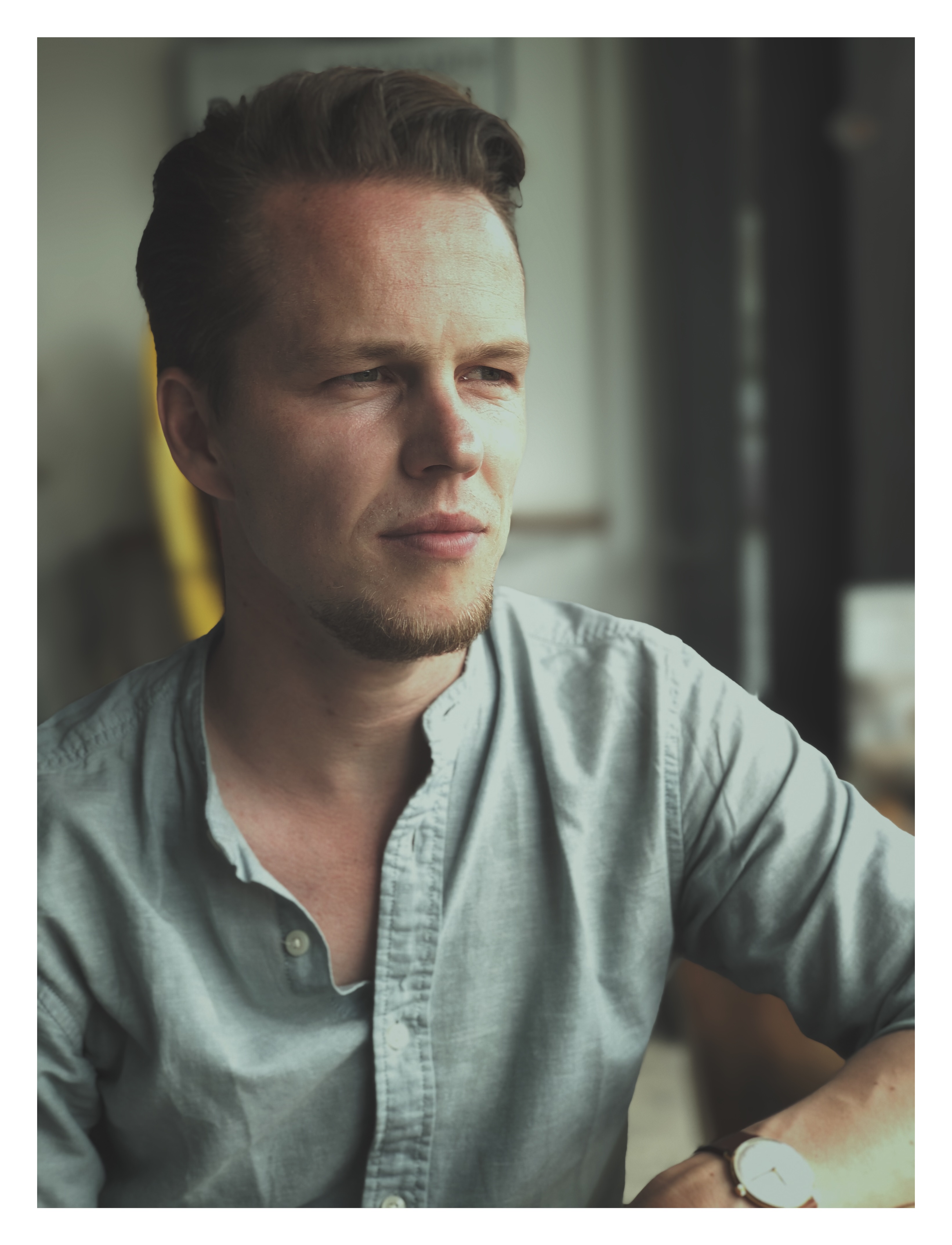What’s the future for pour over coffee?
Innovation is widespread in specialty coffee. Many facets of the market are ever-changing and evolving – and industry professionals and consumers need to keep up with them.
This includes pour over brewing methods. In recent years, we have seen some major changes in how coffee shops and competitors prepare pour overs – largely with an overarching focus on controlling as many extraction variables as possible.
In line with this, a much wider range of manual and automatic pour over brewers are now available – with some models designed to impact brewing variables in different ways.
So it’s clear that pour over coffee is changing. But what might the future hold?
To find out, I spoke to Dušan Matičič, the head roaster at GOAT STORY, Carlos Medina, a barista and the 2023 World Brewers Cup Champion, and Erik Freudenberg, the 2023 German Brewers Cup Champion. Read on for more of their insight.
You may also like our article on the future of espresso.

A brief history of manual pour over coffee
Around the world, filter coffee is immensely popular. In some countries and regions, consumption of filter coffee dates back centuries:
- In Latin American countries like Costa Rica, many people still use traditional wooden chorreador brewers and cloth filters (or bolsitas)
- Touba coffee (or Sufi coffee), which is prepared similar to pour over, is common in Senegal and other West African countries
One of the precursors in the evolution of pour over brewing, however, was the launch of the Melitta brand in the early 1900s. After Melitta Bentz fashioned a pour over brewer using a brass pot and a filter, the Melitta brand became one of the first to start selling commercially-available paper filters. This, of course, revolutionised modern pour over coffee.
Following this, many other companies started to design different variations of manual pour over brewers. In 1941, German scientist Peter Schlumbohm invented the iconic Chemex – which was named “one of the best-designed products of modern times” by the Illinois Institute of Technology.
Other notable manual brewers include the Hario V60 and Kalita Wave. In 2004, Japanese company Hario designed its revolutionary V60 brewer, which quickly became more popular in specialty coffee following the 2010 World Brewers Cup.
The flat bottom Kalita Wave, meanwhile, was officially launched in 2010 by Japanese brand Kalita Co. – which also helped to further elevate pour over brewing methods.
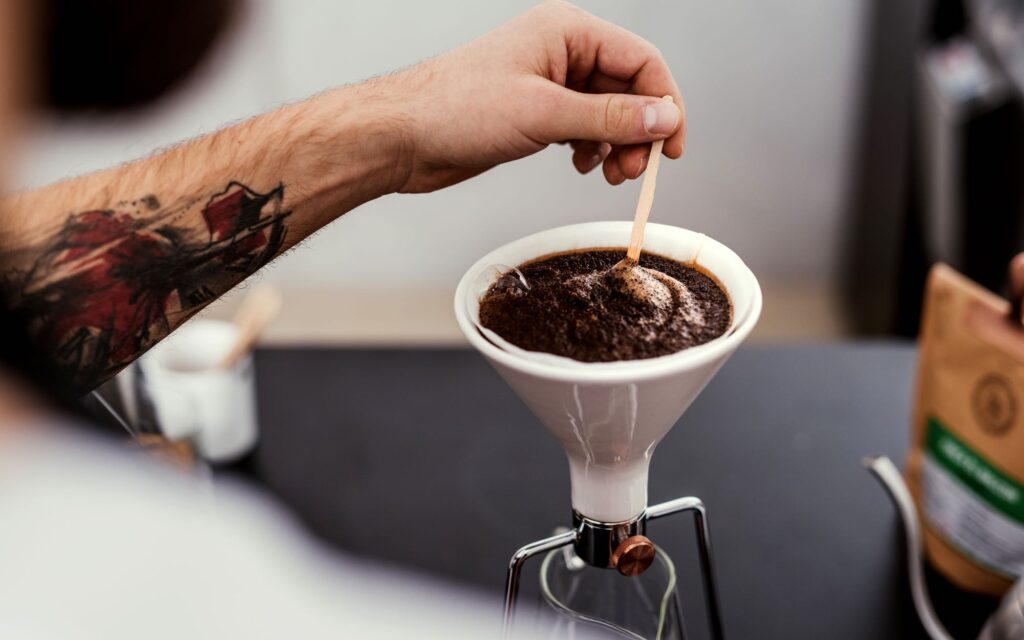
How has pour over changed?
Over the past decade or so, the number of manual pour over brewers available on the market has only continued to grow. Although the V60 still remains one of the most popular, specialty coffee shops are now using a wider range of manual brewers – including the Origami, GINA, Graycano, and Orea, to name a few.
Given the increasing diversity of pour overs, brewing methods are also changing. One of the most noticeable developments has been a much bigger emphasis on precision and controlling as many extraction variables as possible.
Effectively, specialty coffee has become more “scientific” about brewing filter coffee (and espresso), which has helped to deepen our understanding of how certain brewing variables impact extraction.
Erik, who also works part-time as a barista and is an avid home brewer, explains how people have become more willing to experiment with different variables.
“We now know more about how many different brewing variables affect the extraction of flavour, so we therefore feel more comfortable to play around with them,” he says.
The influence of advanced processing methods
Since the early 2000s, specialty coffee has developed a clear preference for single origin coffees – which has thereby influenced filter brewing methods.
In more recent years, however, the increasing popularity of experimental processing methods is also changing how we prepare pour overs.
Dušan roasts coffee for GOAT STORY, which manufactures the GINA coffee maker. This brewer – which was famously used by 2018 World Brewers Cup Champion Emi Fukahori – utilises three different extraction methods (including full immersion, pour over, and cold drip) by turning a valve located at the bottom.
“When I look back to six years ago, as an industry, we were much more focused on clean and crisp washed coffees,” he says. “Pour overs are still the preferred brewing method to best highlight these characteristics.
“Today, however, the diversity of processing methods is much wider,” he adds. “This helps to bring coffees to life. With coffees that have more intense flavour profiles, you need to fine-tune your brewing recipes.
“Generally speaking, it’s simply a matter of how to tone down or enhance complexity,” Dušan continues. “This can be done in so many different ways, from trying different pour over brewers to experimenting with different grind sizes.”
Carlos agrees, and explains how he tweaks his pour over recipes based on the processing method used.
“Heavily fermented coffees are more sensitive, so you have to adapt your recipe to fit,” he tells me. “For instance, I have roasted and brewed coffees which have been fermented for up to 720 hours. In this case, I had to grind coarser and use a lower brewing temperature to avoid extracting undesirable flavours.”
Blends
Despite single origins dominating the specialty coffee market, blends have made something of a comeback in recent years. While we mostly associate blends with flavours more suited to traditional coffee drinkers, there has been renewed interest in higher-quality blends – including at competitions.
This was most noticeable at the 2021 World Barista and Brewers Cup Championships:
- The 2021 World Brewers Cup Champion Matt Winton used a 60:40 blend of naturally processed Coffea eugenioides from Finca Inmaculada in Colombia and washed Catucai from Hacienda La Florida in Peru
- Andrea Allen and Hugh Kelly, who respectively placed second and third at the 2021 WBC, both used blends which included eugenioides
- Additionally, 2022 WBC Japanese competitor Takayuki Ishitani – who placed fourth – used a blend of robusta and an anaerobic fermented Gesha in his routine
Simply put, the process of developing blends has become much more thoughtful and deliberate to create new flavour experiences.
“Single origin coffees are a great way to showcase how terroir and processing impact the final cup profile, but blends can create synergy between different coffees and offer something truly unique,” Carlos says.
Considering that different coffees have different solubility levels, blends certainly impact pour over recipes – meaning we need to tweak brewing variables accordingly to achieve the best results.
Erik used a blend for his 2023 WBrC routine, saying it created one of the most memorable coffees he’s ever tasted.
“I think we’ve reached a point where single origins have become so good by themselves that in order to create an even better experience, we have started to blend multiple exceptional coffees together,” he says. “Blends can shift our perception of flavour altogether.”
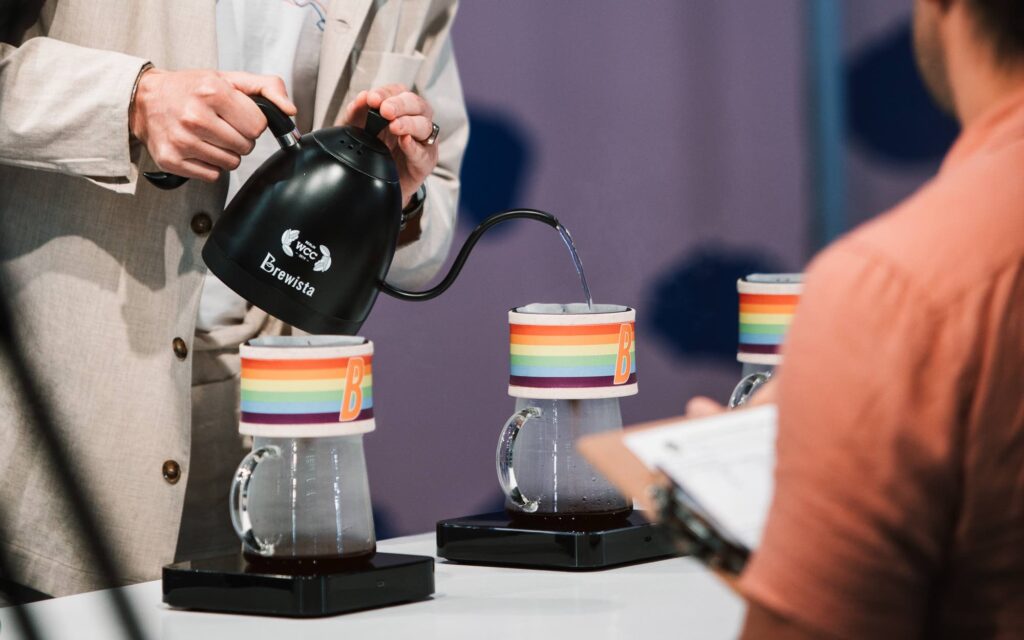
Different brewers, different extraction
When preparing pour overs, the emphasis is very much on the “experience” of making coffee – similar to the Slow Food culinary movement. Essentially, brewing a manual pour over allows you to take your time and become fully immersed in the process.
With so many brewers now available, coffee shops, consumers, and competitors have to change their pour over recipes accordingly to get the best results. Factors such as the shape, design, and material of different manual brewers all influence how coffee is extracted.
“Each model of brewer will have an effect on extraction – whether it’s enhancing certain qualities or making it easier to brew specific coffees,” Carlos says.
For instance, a brewer’s ridge or groove design (as well as the number of ridges it has) will significantly impact flow rate. The V60 has spiral-shaped ridges which help to prevent the filter from sticking to the walls of the brewer – and thereby ensure a more even flow rate.
In comparison, the Orea V3 brewer only has four ridges at the base – which means the flow rate is much quicker. To get the best results between these two brewers, it’s important to change several brewing variables, such as grind size, water temperature, and level of agitation, to name a few.
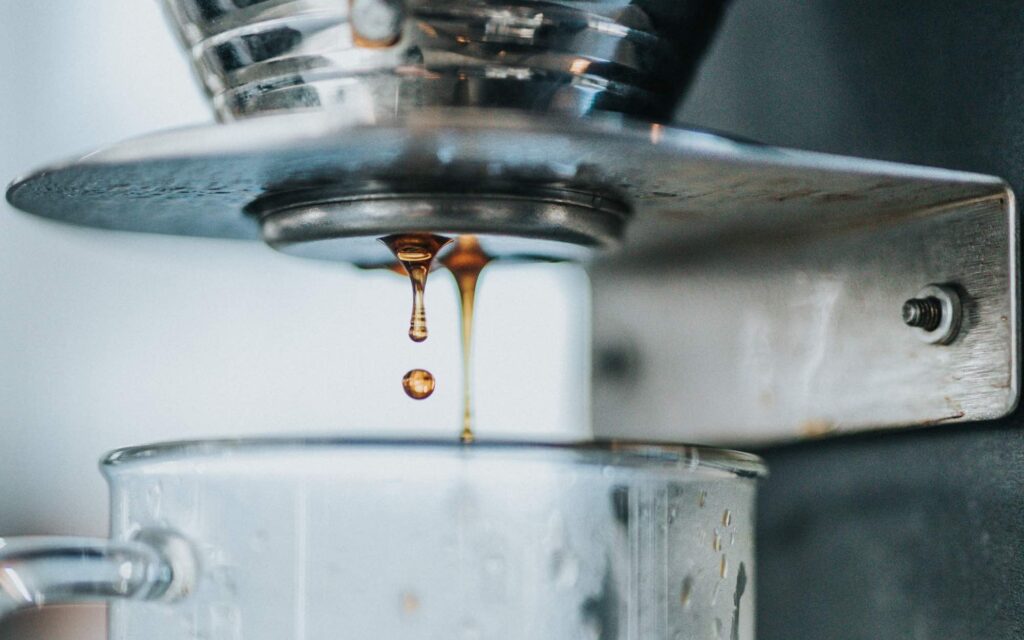
The role of automation
Although manual pour over brewers have evolved significantly in recent years, it’s been hard to ignore how automation has shaped filter coffee brewing for the long term.
Alongside the more scientific approach to pour over extraction, more and more coffee shops have started to leverage the power of automation to serve high-quality filter coffee.
Automated pour over brewing systems can manage a number of variables – such as brew time, temperature, and water dispersion – much more precisely than humans.
“In a coffee shop, automated brewers definitely have an edge on baristas,” Erik says.
Not only does this help baristas to free up more of their time and focus on other tasks, it massively increases the consistency of extraction. In turn, whether you embrace it or not, automation has played a key role in improving the quality of pour over coffee.
Similarly, now more than ever, consumers are also turning to automated brewing solutions at home. We’ve seen more and more companies and brands design high-quality automated pour over systems with a number of features, such as prewetting and blooming functions.

How could pour over coffee evolve in the future?
Given the rapid rate of innovation in specialty coffee, pour over brewing could change in many ways in the years to come.
“We are seeing a growing interest in pour overs,” Dušan says. “People are continuing to explore new ways of brewing, including how to highlight different flavours.”
Carlos believes as the industry’s knowledge of extraction continues to deepen, filter coffee will continue to evolve.
“From automated to hybrid to no-bypass brewers, pour over coffee is sure to evolve to become so much more,” he says.
Erik also agrees, saying: “We will see more super-specialist tools, brewers, and techniques, and we will also gain an even better understanding of the impact of different brewers on coffee flavour.
“I think we will also become more resourceful in our quest to perfect brewing coffee,” he says. “I simply hope that filter coffee becomes even better in the future.”
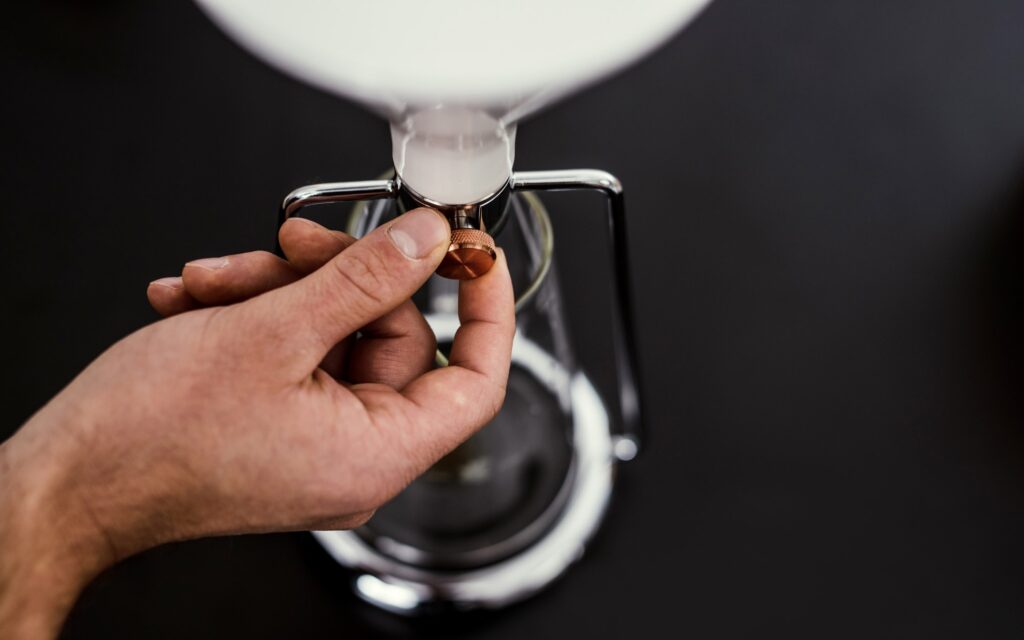
Pour over coffee has come a long way over the past century or so. And with an ever-growing range of manual and automatic brewers – as well as evolving recipes and a deeper understanding of extraction variables – it’s sure to keep on changing.
“There are so many varieties waiting to be rediscovered or cultivated, so the future is bright for filter coffee,” Dušan concludes. “And with the impact of climate change potentially leading to the emergence of new origins, this could bring a new dimension to pour over coffee.”
Enjoyed this? Then read our article on the history of manual brewing methods.
Photo credits: Sinan Musly, SCA Germany, Specialty Coffee Association, World Coffee Events, GOAT STORY
Perfect Daily Grind
Want to read more articles like this? Sign up for our newsletter!


